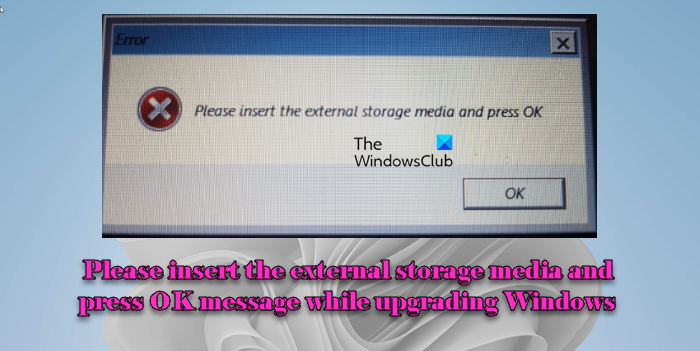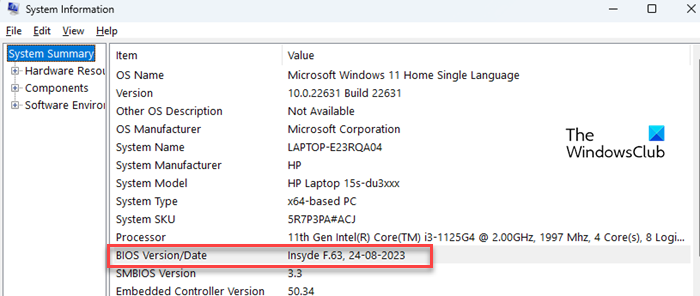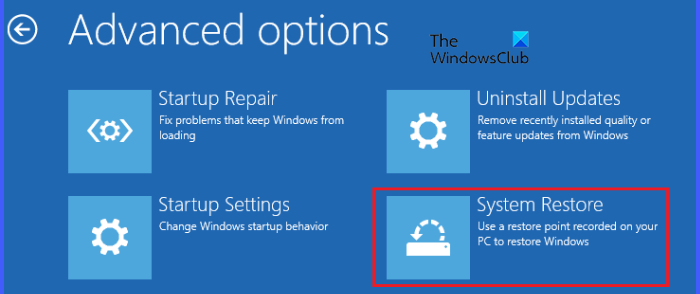If you receive the error message Please insert the external storage media and press OK while upgrading your Windows 11/10 PC, then this post is going to help you.

Several users have reported encountering the message, typically during an update or installation process. The complete error message reads:
Please insert the external storage media and press OK
The most common cause of the error is insufficient internal storage space. Windows may require more space than is available to download, unpack, and install the update files. To address this, it prompts users to insert external storage, such as a USB drive, to temporarily provide the necessary space. Sometimes, even after inserting the external storage, users may still encounter this error if the drive is not formatted correctly (preferably NTFS), is not recognized properly, or if there is a connectivity issue with the USB port.
Please insert the external storage media and press OK
In this article, we are going to show you three straightforward methods to fix the Please insert the external storage media and press OK error, so that in the future you can overcome this error while updating or re-installing Windows OS with the help of an external storage device.
1] Using a USB Port for Your SD Card
While using an SD card to install the new version of Windows on your PC or laptop, you can encounter the above-mentioned error, which appears even after you insert the SD card into your computer. Eventually, the process gets stuck in a loop that needs to be terminated by exiting the setup process.
You can also use a USB adapter to connect the SD card to a USB port on your computer, and users have suggested that this particular method solved the issue. Therefore, follow the steps given below.
First and foremost, you need to plug the USB section of the adapter into the open USB port located on your computer.
You need to ensure that the port you are using is operational and doesn’t cause connectivity issues. Even a slight disconnection might terminate the whole setup.
After executing the previous step successfully, you need to align the SD card in such a way so that the metal grooves are pointed downward, and finally insert the SD card into the adapter.
As soon as the popup message appears, you need to click on the “USB Removable Disk” option on your desktop in order to access the files on the card.
Users have reported that the external storage device you are using as a backup or as a storage device for Windows 11/10 must be a USB storage device and it needs to be connected to a USB port on your computer.
So, if you execute this method successfully, you will almost certainly avoid the “Please insert the external storage media and press OK” error. However, if you are still facing the same issue, follow the next process carefully.
2] Updating BIOS

Any computer’s Basic Input-Output System (BIOS) is embedded software on a motherboard. It is the first software that any PC loads so that it can use hardware components like CD drives, mouse, and keyboards practically from the moment you turn it on.
Updating BIOS can help you deal with certain issues regarding Windows Setup. BIOS updates often include enhanced support for newer hardware. If your external storage device is not recognized, a BIOS update might provide the necessary support for the system to detect and use the device correctly.
Note: Updating the BIOS can be risky. If the process is interrupted, it can render your system unbootable. Before proceeding, ensure you’re comfortable with the procedure, back up your system and data, or seek professional assistance if needed.
Firstly, you need to find out the current version of BIOS which you have installed on your computer by typing “msinfo” command within the “Search” bar present in the “Start” menu.
You can locate the BIOS version just under the Processor model menu. Once you find it, either copy or rewrite it to a text file or a piece of paper. After noting down the BIOS version, you need to prepare your computer for the update.
Visit the official website of your computer’s or motherboard’s manufacturer. Look for the Support or Downloads section and find the latest BIOS update for your model. Download the BIOS update file and any accompanying instructions. Carefully follow the manufacturer’s instructions for applying the update. This might involve running an updater program from Windows or loading the update file from a USB drive during the BIOS setup.
Once the update is done, you will find that the “Please insert the external storage media and press OK” error will be eradicated, and eventually you will be able to update and re-install your Windows easily.
3] Using the “System Restore” option
If none of the above solutions help, you should try performing a system restore by entering the Windows Recovery Environment. You need to access Advanced Startup Options for this.
Firstly, you need to press the “Power” button present on the Windows login screen and then press and hold the “Shift” key. Finally, restart the computer after pressing the “Shift” key.
After executing the previous step successfully, you need to navigate to Troubleshoot > Advanced Options > System Restore.

The System Restore window will open. Click Next to view available restore points.
After selecting a restore point, click Next. Review your choices and click Finish to confirm. A warning will appear indicating that once started, the system restore cannot be interrupted. Click Yes to start the restore process.
If you didn’t succeed, use the Command Prompt way. Navigate to Troubleshoot > Advanced Options > Startup Settings and finally select “Restart.”
Select the “Enable Safe Mode with Command Prompt” option present in the list of “Startup” settings
As soon as the “Command Prompt” window appears, you need to type the cd restore command, and finally press the “Enter” button.
After executing the previous step successfully, you need to enter “rstrui.exe” and again press the “Enter” button.
Finally, in the newly emerged window, click on the “Next” button, select an appropriate restore point, and then click on the “Yes” button to initiate the “System Restore” process.
We hope that at least one of the abovementioned methods will solve this Windows error.
Read: How to Install Windows 11 from a Micro SD Memory Card.
How to update Windows with external storage?
Use a USB drive or an external hard drive with enough free space (at least 16GB to 32GB) to handle the update. Ensure the drive is formatted as NTFS. Connect the drive to your computer and navigate to Settings > Windows Update. Click on Check for updates. If Windows detects that there’s not enough internal storage to complete the update, it will prompt you to use external storage. Select the external drive from the list and follow the on-screen instructions. Windows will transfer the necessary update files to the drive and proceed with the update.
Does updating Windows take up storage?
Updating Windows takes up storage temporarily during the update process and, to some extent, permanently after installation due to new features or improvements. During the update process, Windows downloads and stores update files that may vary in size from a few megabytes to several gigabytes. Additional space is required for unpacking and applying these updates. Also, for significant updates, a Windows.old folder is created to back up the old system version, potentially increasing the overall storage footprint by several gigabytes.
Read Next: 0x800703EE error when copying to external storage on Windows.